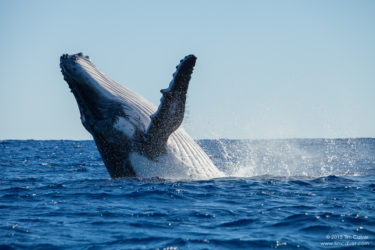I’m at the bottom of the ocean, and I hear singing.
I can’t see them, but their voices are clear, like a bird calling in the night. I wait motionless on the sand bottom under twenty feet of water as reef fish dart around me. I’m listening for whales. The sounds I hear are not deep, slow baritones: the whales chirp like a baby trying out its voice in gurgles and giggles. It sounds like a conversation between whales, talking in rising and falling coos and blips. I can’t help but grin behind my mask.
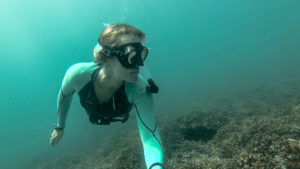
I relax into the diaphragm spasms as I hold my breath: I know I have more than enough oxygen in my blood to stay underwater for at least two minutes, so I focus on what’s coming in through my ears. I can relax on the bottom because of my weight belt, which is one of the keys to using minimal energy while freediving. When I finally feel the stronger tug to take a breath, I push my long fins in a dolphin kick, and, in one movement, ascend from the tranquil bottom. Below, I was suspended in peace, but as I reach into the filtered light I break into a choppy surface. I push hard into my fins to elevate my head and shoulders about the water, searching for signs of whales, a fin or nose poking gently to the air. Only water and the shore.
On the surface, noises assault me from every side: the wind whipping over the water, the explosive, thundering crash of the swell meeting rocks, the water surface itself as it stirs, flops, peaks, and smacks, and the rubbery creak of my mask as I turn my head. Terns cut the air and scream above me, watching to see what I might disturb or reveal. But none of this was audible underwater: there was only the crackle of fish picking at the coral and the whale voices – secret sounds inaudible at the surface.
It’s a silence made from necessity. Not only do sounds travel four times faster through the water than the air (because water is denser,) but a combination of temperature and pressure underwater create sound channels in the ocean that allow noises to travel farther. While the dense water may obscure vision, it illuminates sound. Our marine mammal counterparts rely on their ears to navigate, feed, and congregate, free from the din of the ‘dry’ world.
I’m especially excited to hear these whales because, for the past eight months, we have seen or heard very few. After dodging them daily along the coast of Baja when we first sailed south, we saw only two on the long stretch from Mazatlán, Mexico, to northern Costa Rica. We were in Banderas Bay, the renowned whale watching zone on the central Mexican coast, at the height of the usual whale season. But we never saw a single fin.
Suddenly, in southern Costa Rica and Panama, whales became a daily sight. We have to be aware of whales not only because it’s really fun to catch a glimpse of one of the largest creatures to ever live on earth, but because impact with a whale is one of the most common ways to sink a boat.
We use every sense to detect whales. At night, the only hint of their presence is their breath—the stench of thousands of rotting fish floating downwind. Whenever we smell it, we slow the boat as much as we can immediately and float in the darkness, hoping the whale can sense us.
But even daylight doesn’t guarantee that we will see each other. We search the horizon for the “blow,” the exchange of breath at the surface that can send mist fifty feet in the air. Turns out the shape of the mist can help us identify the species: Humpback sprays, for example, are tall and narrow.
We also search for “footprints” on the surface, an unusually flat circle of disturbed water that hints that a whale is nearby. On our very first sail into Mexico from San Diego, we noticed a footprint, about a five-foot oval of slick water smoothing the surface, only a few feet away. Only a second later, a twelve-foot-long calf surfaced less than a foot from our starboard side. It seemed just as startled and disoriented as we were by the too-close encounter. A wave of alarmed awe caused me to catch my breath as I watched the vulnerable baby try to take in our near miss. Neither the boat nor the whale had the ability to move quickly in the nine-foot swell, so we waited to drift apart.
Months later, we had a curious Minke whale surface only a few yards in front of our bow on a multi-day sail. If Josh had not been watching the water, a monotonous task that many sailors forego, we likely would have collided with the inquisitive creature.
But mostly, interacting with a whale at sea gives us a rare moment where something that lives invisibly in the canyons and mountains below us breaks the barrier between water and air, and we can imagine for a moment that nothing much separates us at all. Because in that moment, nothing does.
So why were we suddenly seeing whales again in Panama?
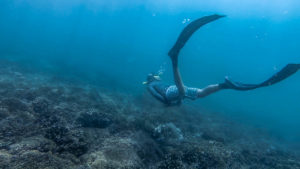
From Ice to Islands
The whales we saw along the entire Pacific coast were mostly Humpbacks, Megaptera novaeangliae. The common name comes from their dorsal fin on their back, which is low and stubby but highly visible when the whale dives from the surface. The Latin name means “Long-winged New Englander,” first described and named in 1756.
Being a New Englander myself, I grew up under the lore and fascination of Humpbacks, some of which come yearly to feed in the Gulf of Maine a few miles from my home. For Christmas, I would get to ‘adopt’ a Humpback: my parents would donate to a whale protection organization, and I would receive a packet in the mail about ‘my’ whale, with info about its habits, and a ten-by-twelve photo. ‘My’ whale could be identified by a photo of the tail flukes it lifted vertically out of the water when the whale starts a deep dive. Humpbacks have black and white pigmentation on the underside of their flukes, each as unique as a human fingerprint. Their long ‘wings’ or flippers, (which are white on both sides for Atlantic animals and only white on the underside in the Pacific,) are likely how they got their name—appendages so long we can see them from over five miles away when they slap the surface.
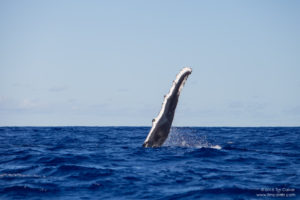
Energetic humpbacks are both fun and easy to watch. They send their 25 to 30 tons, the size of a city bus, hurtling into the air in dazzling displays. If you have ever tried to propel yourself out of the water, you know how hard it is to get a human into the air, never mind something 300 times that weight.
As we sailed further south, we began to see something new: tiny calves matching their mothers’ every move. (Well, not exactly tiny: they’re born at one to two tons and measure nine feet long. They drink 500 gallons of their mothers’ milk per day.) We saw Humpbacks all around the Baja peninsula that make a yearly migration from the Arctic, so I assumed that the Costa Rican whales make that same journey.
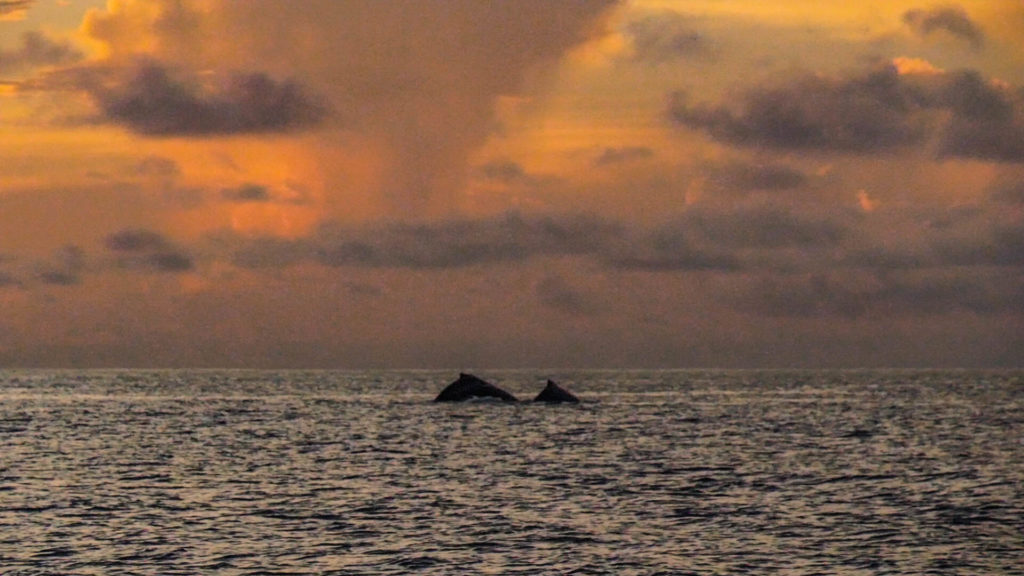
It turns out that the whales in Panama take a much longer trip. They make the only known seasonal migration across the equator, traveling over 6,000 miles from Antarctica. No other creature (without wings) does this, as far as biologists know.
The movement of Humpbacks depends on their food. In the nutrient-rich waters around Antarctica, Humpbacks feed mainly on krill. Krill are small crustaceans that swim in huge swarms. Krill follow their food, too, which is the phytoplankton around Antarctica. Thus, the largest creatures on earth depend on some of the smallest.
Beginning on New Year’s Day, the whales spend the next four months scouring the pack ice around Antarctica as it recedes, feeding twelve to fourteen hours a day. As winter descends in late April or May, the whales start to migrate before ice covers their feeding grounds. In only 30 days they move across the Drake Passage, past Chile on a due north track to hit Peru, then follow the coastline to Costa Rica.
This trip is a huge strain on the animals’ resources: once in tropical water, the mothers often do not eat for the entire three or four months they remain there, yet still must feed their newborn. Whale biologists think they do this because newborn calves have almost no fat, making the cold polar waters dangerous, plus there are fewer predators in the tropics. They spend their winter in Panama or Costa Rica expressly to mate or give birth, so they look for sheltered waters close to shore of a particular temperature and depth.
Warm water is the equivalent of an underwater desert, so while the mother feeds her newborn, she slowly starves. But if everything goes as planned, they will migrate together back to Antarctica for the southern hemisphere summer.
The Antarctic feels like a long way from central Panama, especially from the perspective of a whale or a sailboat, which must cover every inch of sea under its own power. It would take us over one month, in excellent conditions and with no stops, to just get to the tip of South America. But we don’t have to go to the poles to see and feel the changes happening there—the whales bring that change to us. Because of their migration, these whales, upon which many locals depend for tourism, bring the reality of the more extreme and visible climate change happening at the poles straight to tropical waters.
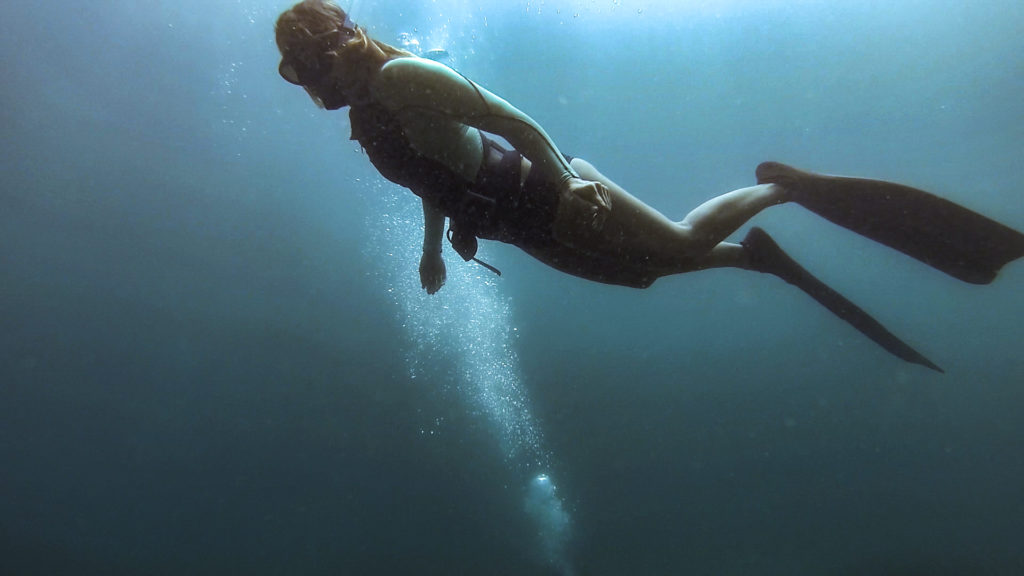
There aren’t many people who want to stand on the frigid bow of a ship in the tempestuous Antarctic for months at a time to study this, but Dr. Ari Friedlaender has made a career of it. In general, scientists know very little about whales, so Friedlaender is in a race to learn as much as he can about the current populations while trying to understand how ocean change impacts whales.
Friedlander tells me the largest change in the Antarctic, from a whale’s perspective, is the amount of time they have sea ice coverage in the Antarctic peninsula: there are 80 fewer days of ice coverage. That’s nearly three months. Sea ice is important for multiple reasons, from the recruitment of krill to protection from predators such as killer whales.
“Humpbacks whales are doing well because they aren’t ice-obligate,” Friedlaender tells me: they don’t rely directly on the ice for food and protection like other whales in Antarctica.
And that isn’t the only reason that the Humpbacks are thriving. They were already rebounding after commercial whaling was banned internationally in 1966. They possess highly adaptable characteristics, including their mating strategies, life histories (they can and will travel to follow food,) their lack of a central breeding ground (they don’t need to go to the same place every time,) and their ability to reproduce quickly (they can breed again less than a year after giving birth.)
In the short term, the lack of ice has been good for them. With three more months to feed, the whales can follow the krill to their inshore habitat, feasting before they take their long and rapid journey north to Panama. It’s also possible, based on the singing that Friedlaender has been hearing, that the whales might be foregoing the tropics to breed in Antarctic waters.
But other species don’t fare as well with change. Blue and Fin whales have not made a similar recovery from whaling like the Humpback. Blue and Fin whales use a central breeding ground, and they cannot easily change where and when they convene to mate. Friedlaender tells me that the Minke whale in particular already struggles with the lack of ice.
“The Antarctic peninsula is a feast of krill, but without sea ice, the Minkes won’t stay there. They avoid predation from killer whales in the ice. And when [the ice] isn’t there, they’re displaced.”
A parallel situation has developed in the Arctic: as the sea ice decreases, the Bowhead whales and narwhals decrease. However, the Humpback population has increased, which pushes the Bowhead whales into an even smaller area, and a positive feedback loop occurs: less ice, more Humpbacks, fewer Bowheads, even more Humpbacks, and even fewer Bowheads.
A Blow to Tourism – and Pristine Places
So what about the whales we didn’t see in Mexico? The absence created problems for the locals who rely on whale watching during the high tourism season from December to March. Without any whales, the guides took boats overloaded with tourists to “esnorkel” at Islas Tres Marietas, the national park at the mouth of Banderas Bay. The “protected” islands became overwhelmingly clogged with tourists. On our trip there, we found ourselves swimming in rough water with hundreds of people. So many flailing bodies producing a visible sheen on the water from sunscreen—which poisons reefs.
On our ride over open water to the park, other guests asked what they could expect. The guide engaged, animated and enthusiastic, until one woman eagerly asked, “Ballenas?” He shifted awkwardly on his feet and turned away quietly. He didn’t even bother to say it might be possible: he knew it wasn’t.
I spoke with Elisa Arcangeli, biologist, guide, and joint owner of Whale Watch Vallarta. In her ten years bringing tourists out on the bay, she never experienced a season anything like last year.
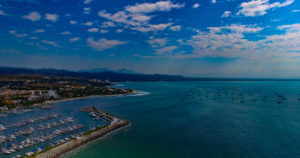
“Many tours, we could look for three hours and never find any whales; many times, we had to come back with no whales.”
Normally, the water temperature in Banderas Bay is a consistent 23 degrees Celsius (74 Fahrenheit) in the winter. But last year, it was 26 to 27 C (80 F.) That may not seem like a lot to us, but it’s significant to the whales. Arcangeli searched in shallow water, in deep water, but it was all the same temperature.
“Last season, we didn’t have a clue where the whales were. They may not have migrated. We heard that there were more than normal in British Columbia [since the whales from the Arctic stopped there to feed and breed.]”
“We had to close a month early.”
Elisa works seasonally and could rely on the support of her family abroad when she closed early. For other smaller guide businesses, which rely entirely on the whale season for their year’s income, the lack of whales set off a chain reaction. Without whales, tours to the national marine park increased. At that point, no limit had been established for park entry, so tourists swarmed the fragile waters and shore. Because the water is rough at these offshore islands, thousands of tourists per day would jump in the water and wash ashore to the only beach. Throngs of boats and people disturbed wildlife above and below the water, and overloaded the water with damaging gasoline and sunscreen. In confidence, a biologist who knows the park told me that, in part because of this shocking impact, she believed the island’s coral would be gone within ten years.
The Baby Boom
At Isla Iguana in the Gulf of Panama, we anchor our boat in deep water, over 40 feet, to accommodate the eighteen-foot tidal swing and avoid the reef near shore. Despite exhaustion from passages in stormy weather and tumultuous anchorages, we take the break in the weather to snorkel near our boat.
As we kick through the strong tidal current, we hear the “pfffuh!” of whale breath. Only a few yards away, a Humpback surfaces. The water is dark and I’m nervous about paddling much closer, so I swim back to the boat and watch, in dumbstruck awe as a mother and calf gently carve the water around the outside of Oleada, just a few feet away.
Friedlaender’s has been looking intensively at calves lately. His current research uses tagging and drones to monitor whales and figure out how well they’re doing by looking at pregnancy rates. The amount of food, of which there has been an excess for Humpbacks at the poles, has a huge impact on a whale’s ability to breed. They can measure images taken with a drone to determine how fat an animal is, and tags let them know how frequently it feeds. He’s observed Humpbacks with a calf and pregnant, an unprecedented sight.
“Climate change isn’t a doomsday scenario for all whales,” Friedlander stresses. “The most absolute is to be able to understand the problem, to be able to quantify it and make predictions. This can help to figure out how to minimize current impacts.”
Humpbacks are a success story in marine conservation: their success demonstrates that small groups of people can achieve success when money, resources, and energy are focused on the things that are critical for these animals.
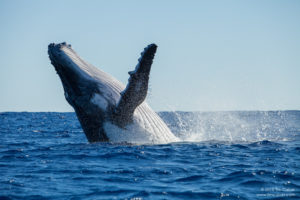
So if not climate, what does this whale researcher think is the greatest overall threat to whales? Friedlaender thinks it’s sound. In California, he’s studied whale behavioral response to Navy sonar, and each species reacts differently—but it’s never positive.
For example, if a beaked whale hears an anthropogenic sound, it stops feeding and moves out of the area immediately. Sometimes, whales or dolphins will surface too quickly, or endanger themselves by using up too much of their air in a panic—just as I will consume far more of my oxygen if I panic when I freedive.
I think of my time spent underwater and the dramatic silence from my perspective as a land dweller. If I were accustomed to that kind of clear quietude, I can imagine that piercing noises would not only possibly cause damage to my hearing, but scare me into escaping or surfacing faster than would be safe.
Underwater sonar affects whales, but over time this can impact the entire population, leading to chronic, long-term population effects. For example, the largest animal ever to have lived on earth has enormous caloric needs, the Blue whale. Missing just one meal can be catastrophic. If a Blue whale abruptly ends a meal once a day or week, this quickly leads to decreased fitness for that individual. Without the right amount of feeding, it loses the ability to give birth at regular individuals, which creates the long-term impact on the population. Blue whales are already endangered, with a population in the low thousands.
“But sound is something we have control over. We can mitigate it,” Friedlaender stresses.
Like most of the people I have interviewed, whether local experts or international researchers, Friedlaender can identify local threats that can be fixed right now. Climate change can feel amorphous and difficult to tackle, since it’s a global problem with complex contributors. However, sonar has a specific source, and researchers and advocates can directly and successfully work with the Navy to eliminate this danger to whales. Likewise, individuals can work to ban dangerous gill nets or lobby to reduce ship speed and therefore whale strikes in shipping channels near feeding grounds. All three of these dangers have been eliminated in specific areas. Local people can identify and knock out local hazards, giving whales fewer threats to contend with as the climate changes.
Meanwhile, the calf that played unmolested in the Gulf of Panama will follow its mother on her call to migrate and re-nourish herself. Humpbacks can live for 50 to 80 years—long enough for the calf to possibly see enormous changes in its surroundings.
That evening at Isla Iguana, the calf attempted a few breaches, noodling around our boat. We watched the two whales, one slow and deliberate, the other clumsy and swirling, until the light faded completely from the sky. Oleada’s anchor held fast in the current as another storm rumbled into the gulf. The pair slipped into the dark horizon, silent for now.
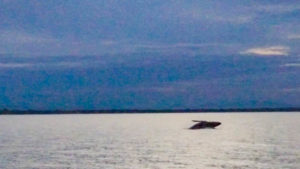
Meanwhile, in Puerto Vallarta, Aranceli tells me their season is back to normal, and she delights in telling me about her daily interactions with Humpbacks in the bay. After ten years, there’s not even a hint of jaded disillusionment with her work. Her eyes sparkle as she tells me that she hopes her tours can be a good way to spread not only knowledge, but love, for whales.
“Hopefully we can teach something about the biological cycle, why the whales do this or that. Because if you know something, you will love it.”
“And if you love it, you will protect it.”

